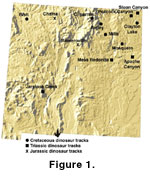INTRODUCTION
 A previously undescribed series of tridactyl dinosaur footprints are described from the Mid-Cretaceous Anapra Sandstone
(Strain 1976) also known as the Sarten Member of the Mojado Formation
(Lucas and Estep 1998;
Kappus et al. in press). The presence of these tracks may expand the southern geographic boundary of the Albian-Cenomanian "Dinosaur Freeway"
(Lockley et al.
1992) or the "Dakota Megatracksite Complex" (Lockley and Hunt
1995) by approximately 500 km. The site described here includes eight moderately well-preserved undertracks and other additional poorly preserved
tracks in a shale quarry on the northern flank of Cerro de Cristo Rey in southernmost Doña Ana County, New
Mexico (Figure 1). Cristo Rey is a hypabyssal andesite pluton of Eocene age
(Lovejoy 1976).
A previously undescribed series of tridactyl dinosaur footprints are described from the Mid-Cretaceous Anapra Sandstone
(Strain 1976) also known as the Sarten Member of the Mojado Formation
(Lucas and Estep 1998;
Kappus et al. in press). The presence of these tracks may expand the southern geographic boundary of the Albian-Cenomanian "Dinosaur Freeway"
(Lockley et al.
1992) or the "Dakota Megatracksite Complex" (Lockley and Hunt
1995) by approximately 500 km. The site described here includes eight moderately well-preserved undertracks and other additional poorly preserved
tracks in a shale quarry on the northern flank of Cerro de Cristo Rey in southernmost Doña Ana County, New
Mexico (Figure 1). Cristo Rey is a hypabyssal andesite pluton of Eocene age
(Lovejoy 1976).
Size and pace length differences among the tracks suggest that at least five individual dinosaurs were present. The direction of progression (parallel to
footlength, see Lockley et al.
1999) of all of the tracks except one is a westerly (present-day) direction. An east-progressing track is the same size as two of the others. It could have been made by one of the five individuals, or it could be the track of a sixth dinosaur.

 A previously undescribed series of tridactyl dinosaur footprints are described from the Mid-Cretaceous Anapra Sandstone
(Strain 1976) also known as the Sarten Member of the Mojado Formation
(Lucas and Estep 1998;
Kappus et al. in press). The presence of these tracks may expand the southern geographic boundary of the Albian-Cenomanian "Dinosaur Freeway"
(Lockley et al.
1992) or the "Dakota Megatracksite Complex" (Lockley and Hunt
1995) by approximately 500 km. The site described here includes eight moderately well-preserved undertracks and other additional poorly preserved
tracks in a shale quarry on the northern flank of Cerro de Cristo Rey in southernmost Doña Ana County, New
Mexico (Figure 1). Cristo Rey is a hypabyssal andesite pluton of Eocene age
(Lovejoy 1976).
A previously undescribed series of tridactyl dinosaur footprints are described from the Mid-Cretaceous Anapra Sandstone
(Strain 1976) also known as the Sarten Member of the Mojado Formation
(Lucas and Estep 1998;
Kappus et al. in press). The presence of these tracks may expand the southern geographic boundary of the Albian-Cenomanian "Dinosaur Freeway"
(Lockley et al.
1992) or the "Dakota Megatracksite Complex" (Lockley and Hunt
1995) by approximately 500 km. The site described here includes eight moderately well-preserved undertracks and other additional poorly preserved
tracks in a shale quarry on the northern flank of Cerro de Cristo Rey in southernmost Doña Ana County, New
Mexico (Figure 1). Cristo Rey is a hypabyssal andesite pluton of Eocene age
(Lovejoy 1976).